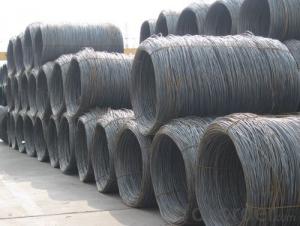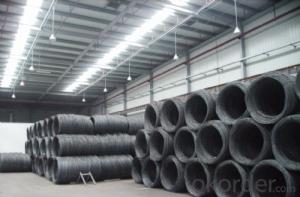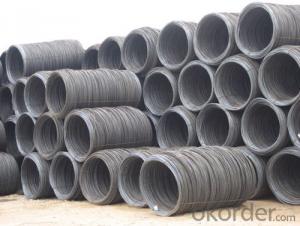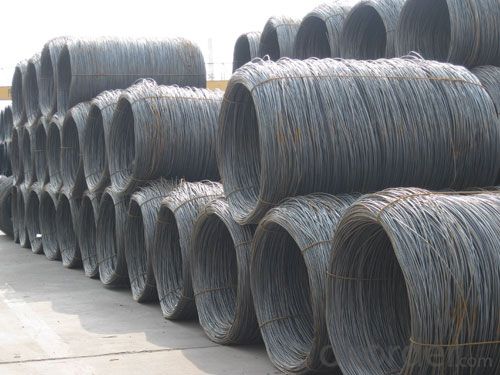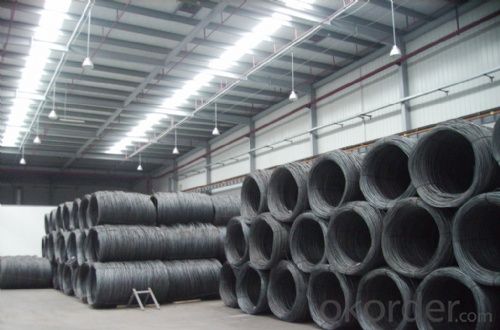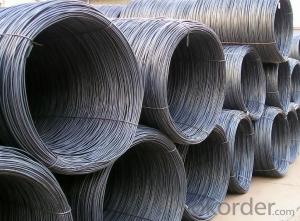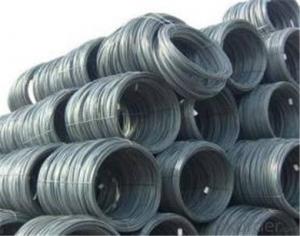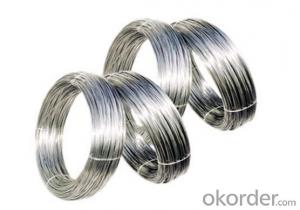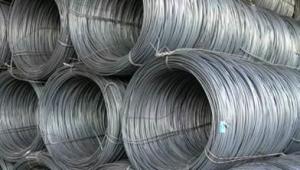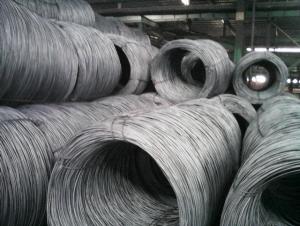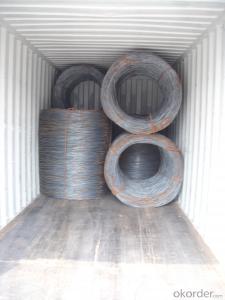SAE1008 Steel Wire Rod with High Quality 5.5mm-12mm
- Loading Port:
- China Main Port
- Payment Terms:
- TT or LC
- Min Order Qty:
- 40 m.t
- Supply Capability:
- 15000 m.t/month
OKorder Service Pledge
OKorder Financial Service
You Might Also Like
Production Description:
Specifications of Wire Rod SAE1008B:
Grade: SAE1008B Standard: ASTM
Diameter: 5.5mm, 6.5mm, 7mm, 8mm, 9mm, 10mm, 11mm, 12mm
Alloy or Not: Alloy
Technique: Hot Rolled Place of Origin: China Mainland
Chemical Composition:
Please kindly find our chemistry of our material based on SAE1008B as below for your reference:
Grade | Chemical Composition (%) | |||||
C | Mn | S | P | Si | B | |
SAE1008B | 0.10max | 0.30-0.50 | 0.050max | 0.040max | 0.30max | 0.0008min |
Mechanical properties | ||||||
Yield strength(N/mm2) | Tensile strength(N/mm2) | Elongation (%) | ||||
≥195 | 350-380 | ≥32 | ||||
Usage and Applications of SAE1008 Steel Wire Rod with High Quality 5.5mm-12mm:
After hot-rolled the products shaped into coil and delivery as finished product, including round, square,rectangular, hexagonal and so on. Since most of the products are round, it is generally called wire rod. Carbon steel wire rod is widely used in construction and manufacturing. Carbon steel wire rod is mainly used for reinforcement of reinforced concrete and welded structure or reprocessed (roberts , nail, etc.) materials, especially used to produce wire drawing, welding electrode, nails, spring, electronic, precise machinery parts and so on.
Packaging & Delivery of SAE1008 Steel Wire Rod with High Quality 5.5mm-12mm:
Packaging Detail: products are packed in coil and then shipped by container or bulk vessel
Each coil weight: About 2.05MT
Delivery Detail: within 45 days after received deposit or LC.
Label: to be specified by customer, generally, each bundle has 1-2 labels
Trade terms: FOB, CFR, CIF
FAQ:
Q1: How soon can we receive the product after purchasement?
A1: Within three days of placing an order, we will begin production. The specific shipping date is dependent upon international and government factors, but is typically one month.
Q2: How do you guarantee the quality of our products?
A2: We have established an advanced quality management system which conducts strict quality tests at every step, from raw materials to the final product. At the same time, we provide extensive follow-up service assurances as required.
Q3: The prices are invoicing on theoritical weight or on actual weight?
A3: We can do it in both manners, according to the customers' request.
Images of SAE1008 Steel Wire Rod with High Quality 5.5mm-12mm:
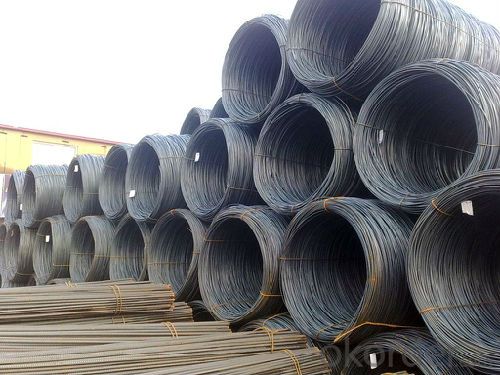
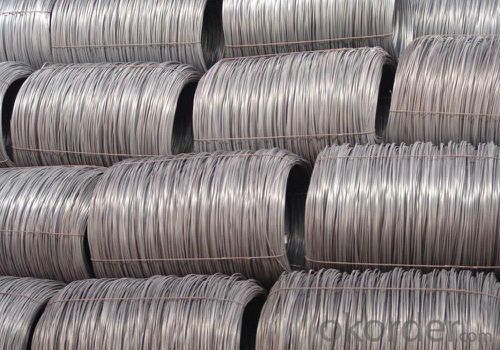
*If you would like to get our price, please kindly inform us the size, standard/material and quantity. Thank you very much for your attention.
- Q: What are the main factors affecting the market forecasts of steel wire rod?
- The main factors affecting the market forecasts of steel wire rod include global demand and supply dynamics, economic growth and industrial activity, raw material prices and availability, technological advancements, government regulations and policies, and competition within the industry. Additionally, factors such as geopolitical events, currency fluctuations, and environmental considerations can also influence market forecasts for steel wire rod.
- Q: What are the different production processes involved in steel wire rod manufacturing?
- The manufacturing of steel wire rods involves several production processes. These processes are crucial in transforming raw materials into the final product. Here are the different production processes involved in steel wire rod manufacturing: 1. Ironmaking: The steel wire rod manufacturing process begins with ironmaking. Iron ore is extracted and processed in a blast furnace to produce pig iron. The pig iron is then further refined to remove impurities and create steel. 2. Steelmaking: In the steelmaking process, the pig iron is melted in a furnace and alloyed with various elements such as carbon, manganese, and silicon to achieve the desired steel properties. This process ensures that the steel meets the specific requirements of wire rod production. 3. Continuous Casting: After steelmaking, the molten steel is cast into billets or blooms using continuous casting technology. This process involves pouring the molten steel into a water-cooled mold to solidify it into a specific shape. For wire rod production, the billets are typically cast in a square cross-section. 4. Hot Rolling: The next step is hot rolling, where the billets are reheated and passed through a series of rolling mills. These rolling mills reduce the billets' cross-sectional area and elongate them into wire rod form. The hot rolling process improves the mechanical properties and surface finish of the wire rods. 5. Cooling: Once the wire rods are hot rolled, they undergo a cooling process to achieve the desired properties. Cooling can be done through air cooling or water spray cooling, depending on the specific requirements of the wire rods. 6. Surface Treatment: After cooling, the wire rods undergo surface treatment processes such as pickling or coating. Pickling involves removing any scale or oxide on the surface of the wire rods using acid solutions. Coating may involve applying a protective layer to prevent corrosion or improve the wire rods' performance in specific applications. 7. Inspection and Quality Control: Throughout the manufacturing process, the wire rods undergo rigorous inspection and quality control measures. This ensures that the wire rods meet the required standards and specifications. Various tests, such as tensile strength, elongation, and dimensional checks, are conducted to ensure the quality of the wire rods. 8. Packaging and Delivery: Finally, the wire rods are packaged according to customer requirements and prepared for delivery. They may be bundled, coil-wound, or packaged in other forms, depending on the customer's needs. The wire rods are then transported to the customers, where they can be further processed or used in various applications. These production processes play a vital role in the manufacturing of steel wire rods, ensuring that they meet the required specifications and are suitable for different applications in industries such as construction, automotive, and manufacturing.
- Q: How is the competitive landscape of the steel wire rod market?
- The competitive landscape of the steel wire rod market can be described as highly competitive, with numerous players vying for market share. Key factors influencing competition include pricing strategies, product quality, technological advancements, and customer relationships. Additionally, the market is characterized by consolidation as larger companies acquire smaller ones to strengthen their position. Overall, intense competition in the steel wire rod market compels companies to constantly innovate and differentiate themselves to stay ahead.
- Q: What are the different types of steel wire rod surface defects and their detection methods?
- During the manufacturing process, various types of defects can occur on the surface of steel wire rods. These defects can have a significant impact on the quality and integrity of the wire rods, so it is crucial to identify and address them before they cause further issues. Here are some common surface defects of steel wire rods and the methods used to detect them: 1. Scale: Oxide layers can form on the surface of wire rods due to exposure to high temperatures during production. Scale can be visually detected by looking for discoloration or by performing a scratch test to see if the scale flakes off easily. 2. Cracks: Surface cracks can be caused by factors like improper cooling, excessive stress, or material defects. Visual inspection is commonly used to detect cracks, but more accurate methods like magnetic particle inspection or ultrasonic testing can also be utilized. 3. Pitting: Pitting refers to small depressions or cavities that form on the surface of wire rods due to corrosion or mechanical damage. Visual inspection is usually sufficient to identify pitting, but techniques like dye penetrant inspection or eddy current testing can be employed for a more detailed examination. 4. Surface roughness: Irregular or uneven texture on the surface of wire rods is known as surface roughness. It can be a result of improper manufacturing processes or inadequate quality control. Visual inspection or the use of a profilometer to measure roughness quantitatively can help detect surface roughness. 5. Inclusions: Non-metallic substances, such as slag, dirt, or oxide particles, can become embedded in the surface of wire rods, causing weak spots or affecting mechanical properties. Visual inspection can identify large inclusions, while microscopic examination or techniques like X-ray inspection can detect smaller or subsurface inclusions. 6. Coating defects: If a wire rod has a coating, defects like peeling, blistering, or uneven thickness can occur. Visual inspection is generally sufficient, but techniques like ultrasonic testing or electrical conductivity measurements can provide a more comprehensive assessment. It is important to note that while visual inspection is commonly used, more advanced non-destructive testing (NDT) methods can offer more accurate and reliable detection of surface defects. By employing a combination of these methods, the identification and rectification of surface defects in steel wire rods can be ensured, ultimately enhancing their quality and performance.
- Q: How is the steel wire rod market segmented?
- The steel wire rod market is typically segmented based on product type, application, and geography.
- Q: What are the different sizes and diameters available for steel wire rod?
- Different sizes and diameters of steel wire rods are available to cater to various applications and industries. The range of sizes typically falls between 5.5mm and 20mm, with common sizes including 6mm, 8mm, 10mm, 12mm, and 16mm. The diameter of a steel wire rod determines its strength and load-bearing capacity, referring to its thickness or width. The required diameter depends on the intended use of the wire rod. Heavy-duty applications, such as construction, often require thicker diameters, while lighter applications like fencing or wire mesh can use thinner diameters. To meet the diverse needs of industries like construction, automotive, manufacturing, and agriculture, manufacturers produce steel wire rods with various diameters. Customers can choose the appropriate size and diameter based on the specific requirements of their project or application to ensure optimal performance and durability.
- Q: What are the different surface finishing materials used for steel wire rod?
- There are several surface finishing materials that are commonly used for steel wire rod. Some of these materials include zinc, copper, nickel, and chrome. These finishes are applied to the steel wire rod to enhance its corrosion resistance, improve its appearance, and provide additional functionality such as improved conductivity or lubricity.
- Q: What are the common production processes for radium-coated steel wire rod?
- The common production processes for radium-coated steel wire rod typically involve several steps. First, the steel wire rod is cleaned and prepared to ensure its surface is free from impurities. Then, it undergoes a process called electroplating, where a thin layer of radium is deposited onto the surface of the wire rod using an electric current. This electroplating process ensures a uniform and controlled coating of radium. Finally, the radium-coated steel wire rod is thoroughly inspected and tested for quality assurance before it can be used in various applications such as medical devices, research equipment, or industrial machinery.
- Q: What are the different types of steel wire rod finishes for improved paint adhesion?
- There are several types of steel wire rod finishes that can be used to enhance paint adhesion. Some common finishes include phosphate coatings, zinc coatings, and polymer coatings. These finishes create a rough surface texture that allows the paint to adhere more effectively to the wire rod, providing better durability and corrosion resistance.
- Q: How is steel wire rod used in the production of mesh fencing?
- Steel wire rod is an essential component in the production of mesh fencing. The wire rod serves as the primary material used to create the individual wires that are woven or welded together to form the mesh pattern. To begin the manufacturing process, the steel wire rod is first processed through a series of mechanical operations such as drawing and annealing to enhance its strength and flexibility. This ensures that the wire is durable and capable of withstanding external forces and environmental conditions. Once the wire rod has been processed, it is then fed into a machine that transforms it into individual wires with the desired diameter. These wires are then woven or welded together to form the mesh pattern commonly seen in fencing. Woven mesh fencing is created by interlocking the wires in a crisscross pattern, resulting in a sturdy and flexible structure. This type of mesh fencing is commonly used in agricultural applications, such as livestock enclosures or perimeter fencing. On the other hand, welded mesh fencing is made by welding the wires at their intersection points, creating a rigid and strong mesh structure. Welded mesh fencing is frequently used in industrial settings, construction sites, or for security purposes, as it provides a high level of strength and durability. In both cases, the steel wire rod is the crucial raw material that forms the foundation of the mesh fencing. It ensures that the fencing is capable of withstanding various external factors such as weather conditions, impacts, and pressure. Additionally, steel wire rod is often galvanized or coated with protective materials to enhance its resistance to corrosion, further increasing the longevity and durability of the mesh fencing.
Send your message to us
SAE1008 Steel Wire Rod with High Quality 5.5mm-12mm
- Loading Port:
- China Main Port
- Payment Terms:
- TT or LC
- Min Order Qty:
- 40 m.t
- Supply Capability:
- 15000 m.t/month
OKorder Service Pledge
OKorder Financial Service
Similar products
Hot products
Hot Searches
Related keywords
